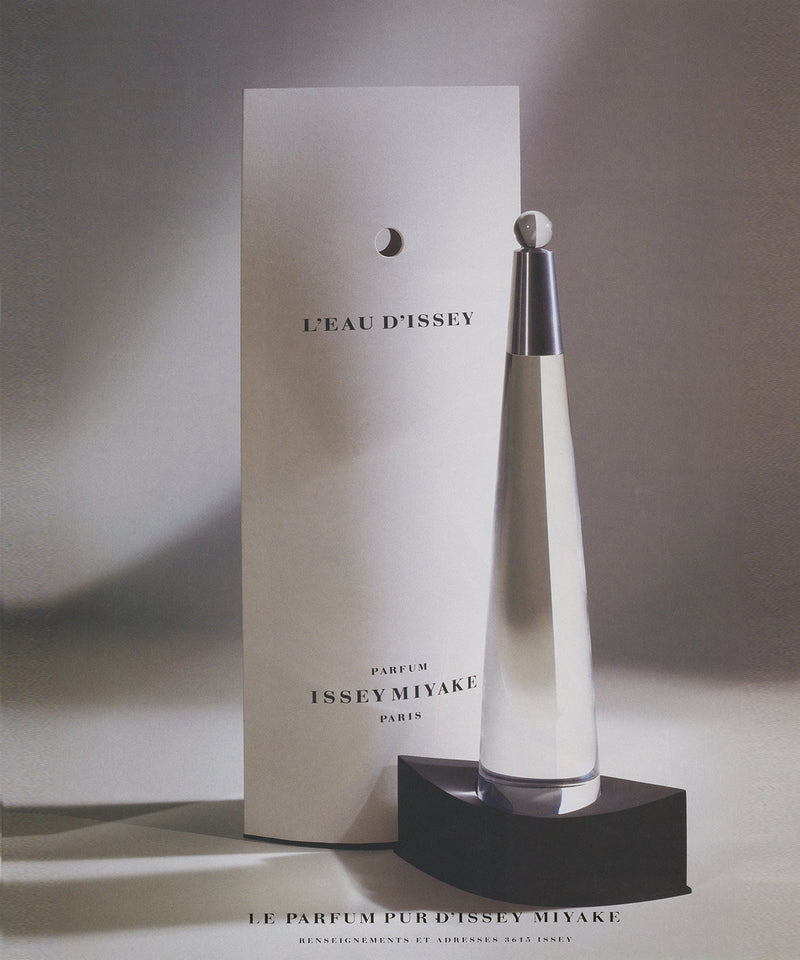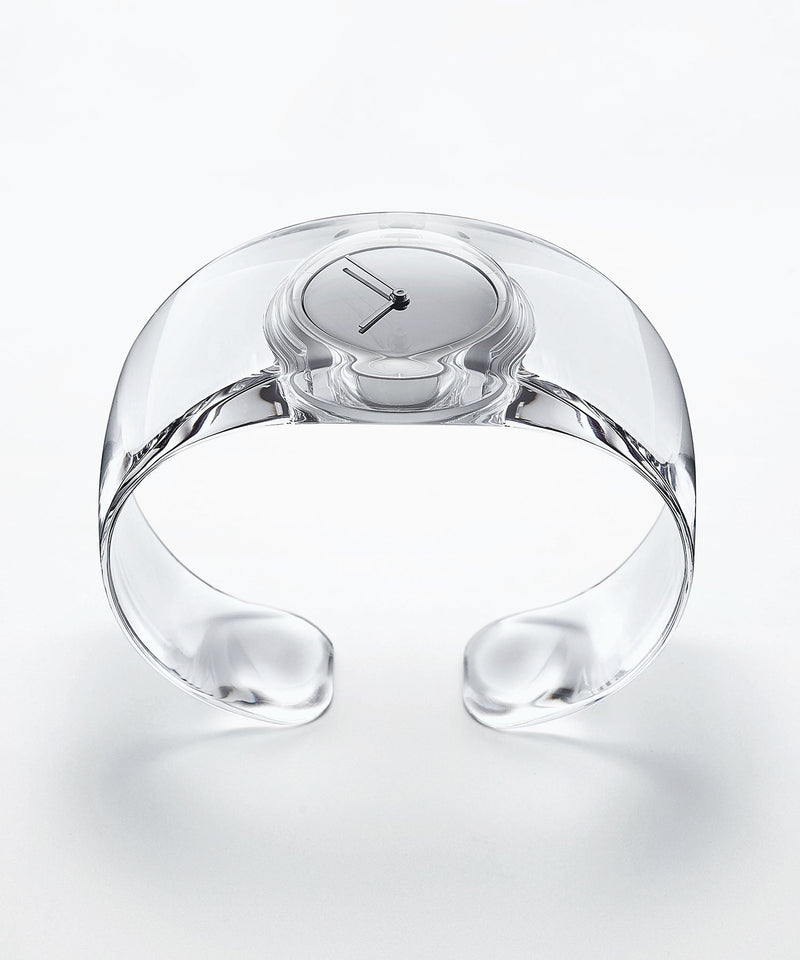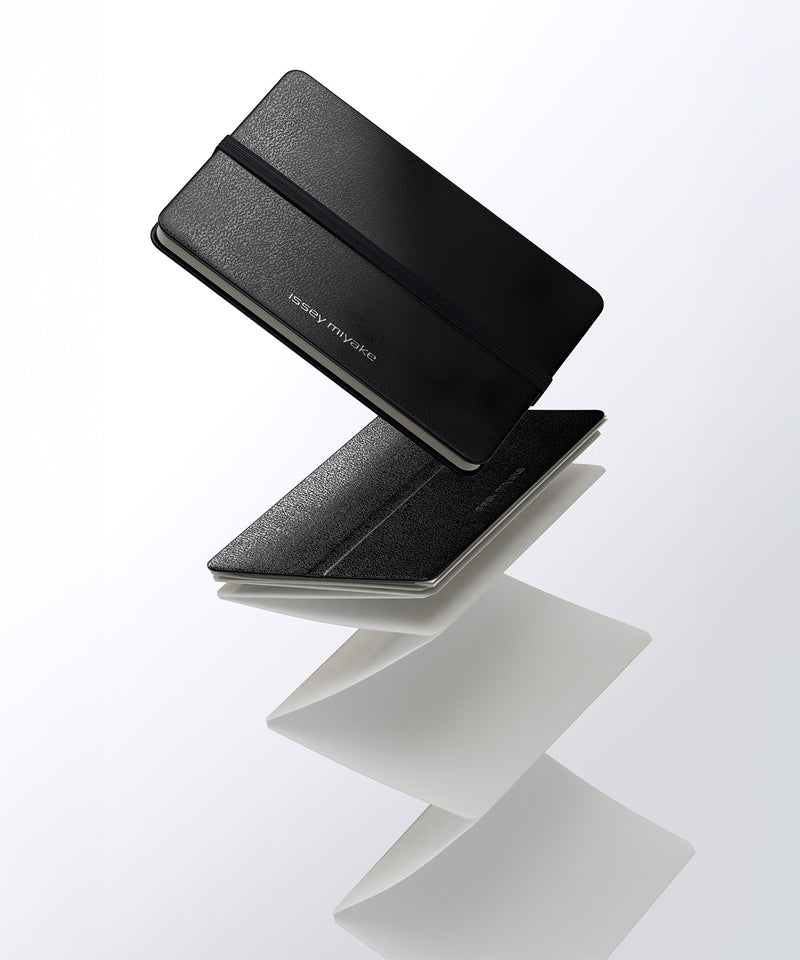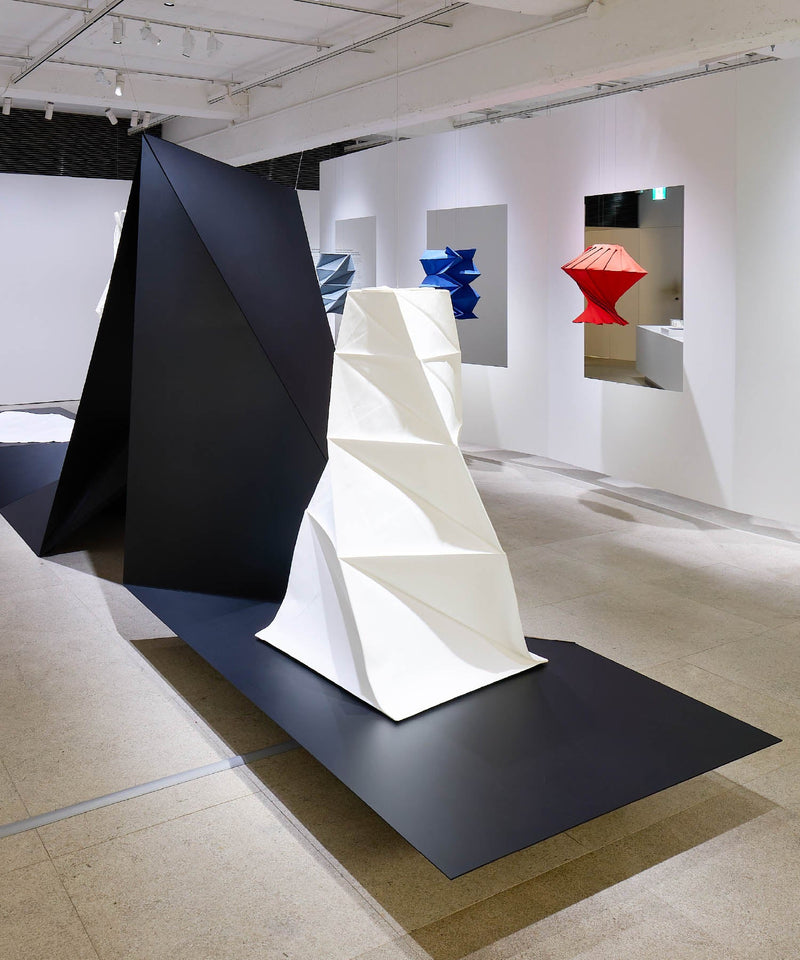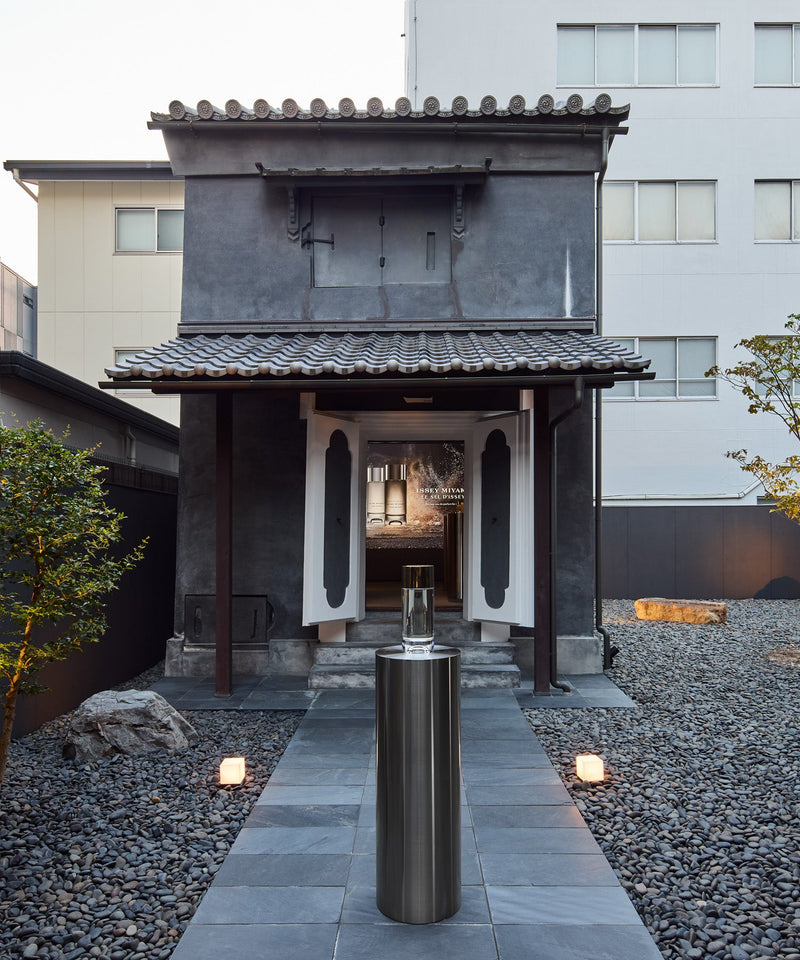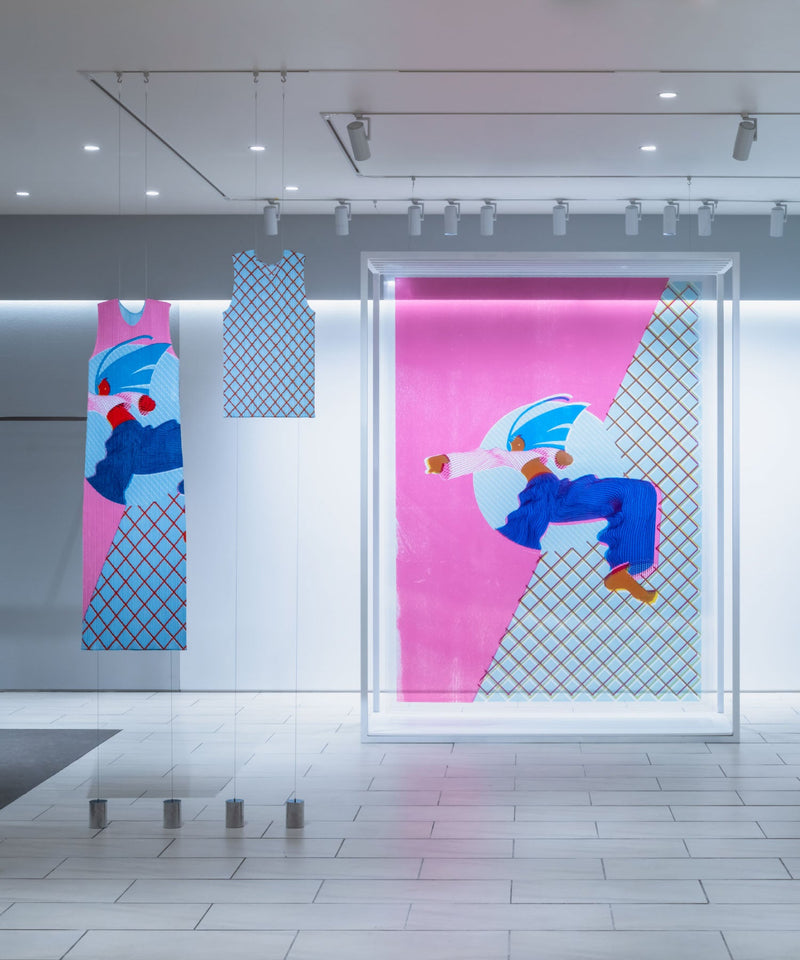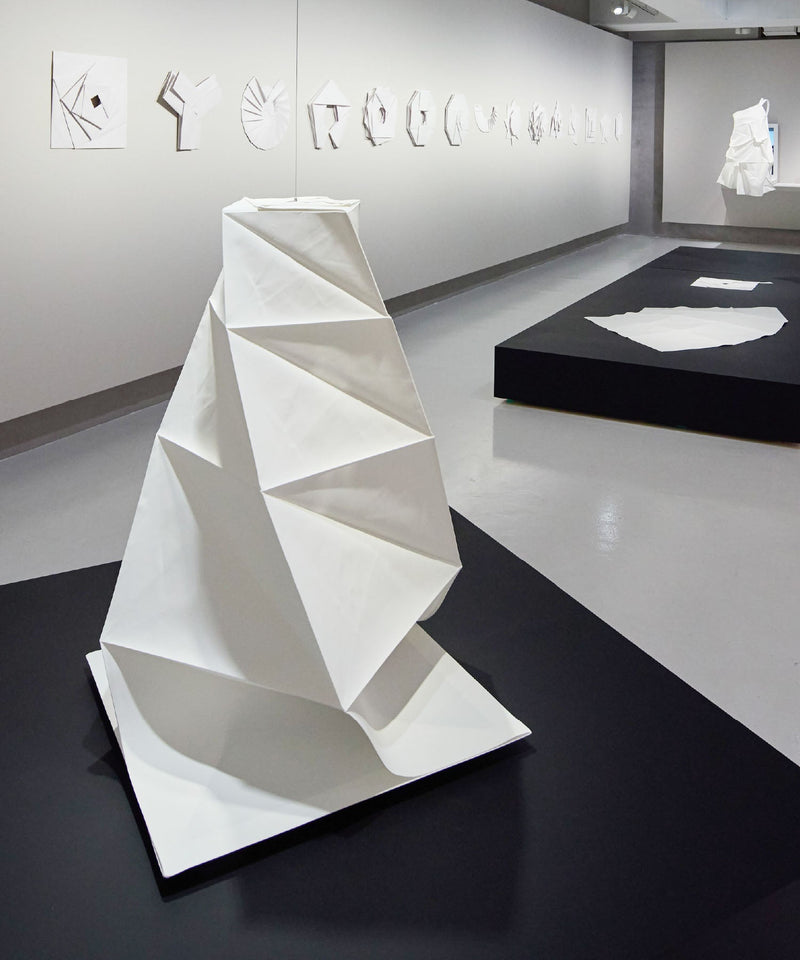Episode 7
“Taking Detours with AI”
by Kazuya Kawasaki+Kotaro Sano (Synflux)
Artificial intelligence has gradually been implemented across various fields of society and is becoming increasingly relevant in manufacturing as well. Synflux is a laboratory that leverages advanced technologies such as AI and 3D modeling to develop sustainable and highly creative design systems. In collaboration with A-POC ABLE ISSEY MIYAKE, they are working on the “TYPE-IX Synflux Project.” What technologies, ideas, and processes for the future are embedded in this project? We dive deeper into the conversation with Synflux’s CEO Kazuya Kawasaki and COO Kotaro Sano.
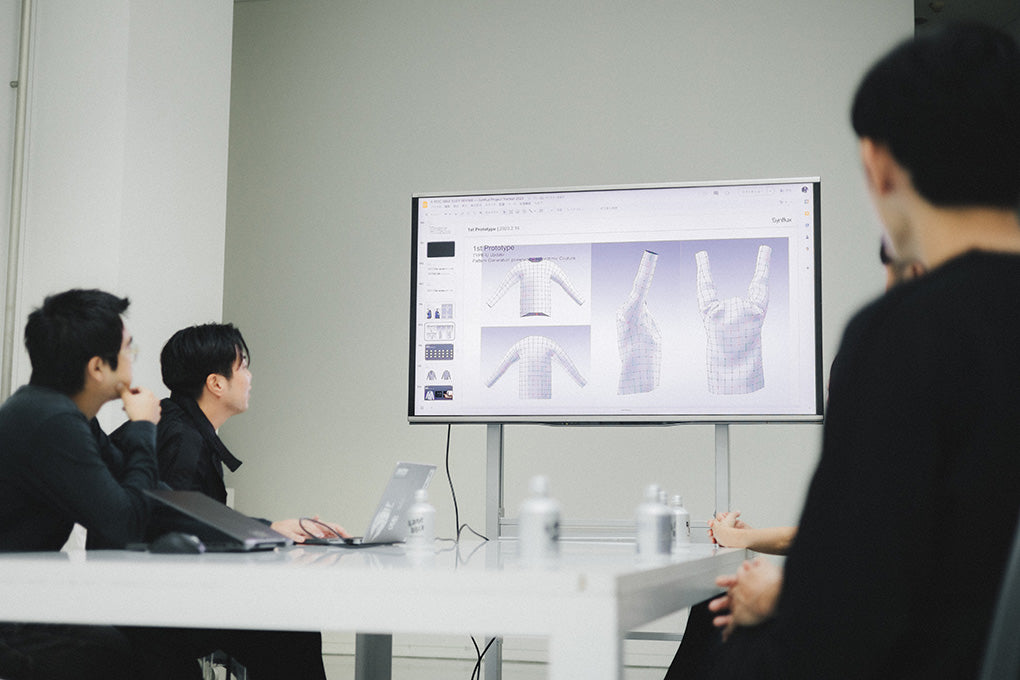
Bold and unconventional transitions run vertically and horizontally across the garments. The two jacket designs created through the “TYPE-IX Synflux Project” seem to embed a multifaceted array of “information”. This includes the efficiency of reducing textile waste, the functionality and aesthetics of clothing, and the nature of creativity in the age of AI.
This project, based on A-POC ABLE’s original shape-memory material “TYPE-U,” utilizes Synflux’s design system, Algorithmic Couture, to generate a vast array of pattern simulations, which are then evaluated and interpreted by the engineering team and developers, to progress through repeated trial and error. In other words, these complex yet rational patterns are the result of a dialogue between algorithms and humans.
Of course, an ideal pattern has already been drafted by the design engineers. Yet the question remains: can even more beautiful and efficient lines be drawn? Through its encounter with the technology of algorithms developed by Synflux, A-POC ABLE’s manufacturing process has been prompted to face new questions. This dialogue begins with the events that sparked this transformation.
──It seems that the encounter between you, Kawasaki-san, and Miyamae-san was initiated by the 2020 exhibition “TADANORI YOKOO ISSEY MIYAKE 0.”
Kazuya Kawasaki (“Kawasaki” below): That’s right. The news that Miyamae-san was reviving “A-POC” was a big deal for us. When I heard about the collaboration with Tadanori Yokoo, I went to the gallery at Daikanyama T-SITE. It was breathtaking. The mannequins wearing the blousons were made using a 3D printer and a massive 1,800mm-wide textile was dynamically displayed. The use of colors and patterns was beyond anything I could have imagined. I couldn’t stop saying, “Amazing!” and “How is this even possible?” It was through a mutual acquaintance that I got the chance to speak with Miyamae-san.
──At that time, had “Algorithmic Couture” already been developed?
Kawasaki: The system development had started, but it was still in its embryonic stage or even before that, so to speak. Nevertheless, I was determined to talk to Miyamae-san. From my student days, I had been greatly influenced by Issey Miyake’s words. For example, there’s the famous episode from the 1960 World Design Conference, where the young Miyake-san, still a student, sent a letter to the organizers asking why clothing wasn’t included as a topic. It surely stemmed from his belief in clothing as something that shapes life and society, and the importance of design for that purpose.
I have always been more interested in the creation and design processes of fashion than its symbolic aspects. Miyake-san’s actions and words resonate deeply with me. There is this mysterious and often overused word, creation, which sometimes makes fashion seem like it magically conjures garments. But clothing as part of our daily lives is surely more than just that.
I also feel a deep connection to Miyake-san’s concept of “a piece of cloth”. It’s not just a method of making, but also a philosophy. Our algorithm-driven design system is rooted in similar principles: how to use fabric efficiently and how to incorporate geometric and computational methodologies into fabric and garment design. There is significant overlap in our approaches. So when I heard that Miyamae-san was reviving A-POC, I couldn’t sit still. I jumped at the opportunity to make a proposal.
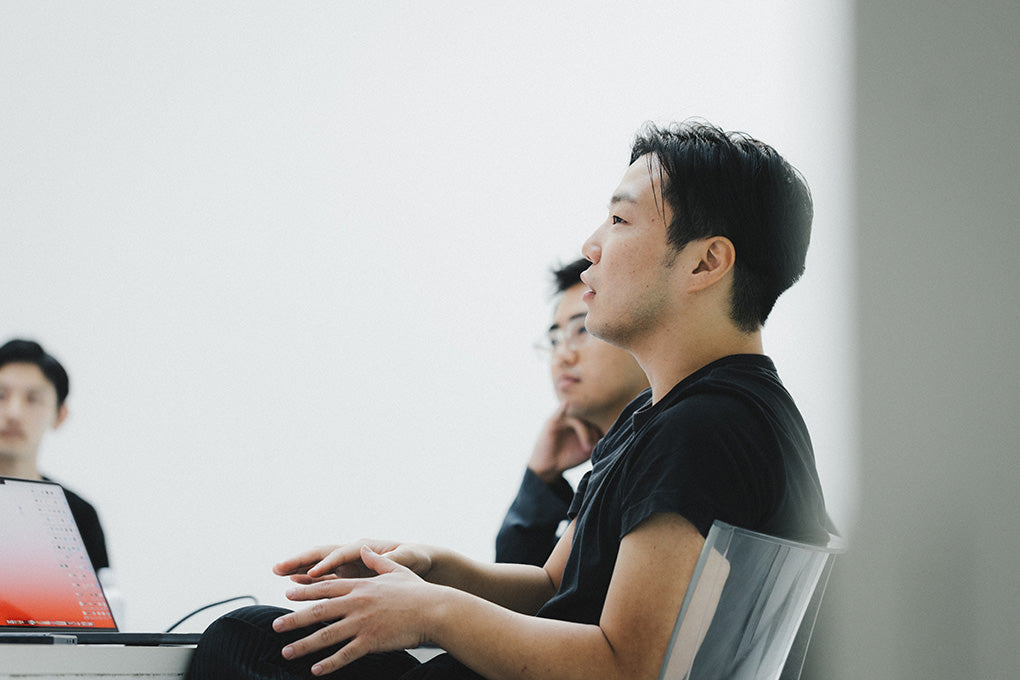
Yoshiyuki Miyamae (“Miyamae” below): As you just mentioned, you had conducted extensive research on Issey Miyake, and the proposal you presented was truly impressive. It gave me a sense that there was a fresh perspective to gain. What we aim to achieve at A-POC ABLE, is to innovate from the manufacturing process itself. It is essential to take a broad, cross-sectional view of the entire process, from upstream to downstream.
For example, sustainability is an issue that the entire industry must address. However, trying to solve it within the constraints of existing structures is becoming increasingly difficult. Highly specialized fields influence one another, and even if there’s a solution for one part, executing it requires optimizing the entire system. That’s why I felt a great deal of potential in Kawasaki-san’s unique expertise and technologies from a different field, which could provide a completely new perspective for rethinking manufacturing.
After all, we are dealing with technologies based on intelligence, such as AI and algorithms, which are fundamentally different from human abilities. These might generate methods and approaches we could have never imagined. At the same time, there is a lot we don’t yet understand about which aspects of manufacturing these technologies can truly take on. That’s why, initially, we decided to start the project slowly, without setting specific goals, and focus on exchanging conversations with Kawasaki-san and his team at our own pace.
──Like in many of your past collaborative projects, it seems the process started with conversations.
Miyamae: That was the initial idea. But Kawasaki-san’s presentation skills were so impressive (laughs) and he kept coming up with new proposals one after another! Naturally, some aligned well with our vision, while others didn’t quite fit, but the sheer volume of ideas was utterly refreshing.
There were plans that explored the uniqueness of shapes and colors, which highlighted the potential of algorithmic technology, something without a physical form. Synflux, however, had a clear mission: to reduce textile waste and loss within the manufacturing process. So we decided to start by setting a practical example that could address this mission while integrating it with our technology, and that example was the “TYPE-U”, one of A-POC ABLE’s most basic jackets.
Kawasaki: There were several moments during this project where I felt things really took off, and one of them was just as Miyamae-san mentioned. Targeting the “TYPE-U” jacket, a product with a sense of universality and deep-rooted practicality in daily life, gave us a clear focus. This starting point allowed us to utilize algorithms with greater freedom.
The second moment was when we discussed linking the project to Issey Miyake’s early collections, specifically the “knife-cutting” technique, an approach inspired by the precise knife skills of a traditional Japanese chef. Incorporating that concept into our prototypes gave new meaning to the pattern lines generated by Algorithmic Couture. It was at that point that the purpose and significance of these algorithmic patterns became much clearer.
──The ability to generate endless patterns makes it all the more important to assign meaning, doesn’t it?
Kawasaki: AI excels at statistics and inference but it lacks a body and cannot comprehend meaning. On the other hand, fashion and clothing absolutely require both physicality and meaning. This is one of the reasons why combining fashion with AI is considered challenging. However, once meaning and context emerge within us, we can direct the parameters to generate patterns through algorithms and evaluate the generated patterns effectively.
Another memorable moment was when Nakatani-san casually said, “From here onwards, let’s communicate through patterns”. That marked the beginning of a process where we generated patterns, received feedback, and experimented repeatedly. Through this trial and error, we began to uncover the fine details and rules that A-POC ABLE holds dear, as well as aspects of garment production processes we had not yet learned. In short, this highlighted the idea that only through the act of making does data gain physicality. It became clear that we needed to engage deeply with garments, which encapsulate an incredible density of information, to truly understand and refine our approach.
──I see. Nakatani-san, why did you say “Let’s communicate through patterns”?
Manabu Nakatani (“Nakatani” below): For us, too, collaborating with technologies like algorithms and artificial intelligence was a completely new experience. While we weren’t rejecting what we had protected and valued until now, we had, in some ways, avoided technologies that seemed to take creation out of human hands, such as 3D modeling. Perhaps we felt that it was a field which required a certain courage to step into. Despite all of that, we sensed a strong passion from Kawasaki-san and it made us want to match his enthusiasm. Saying “Let’s communicate through patterns” might have been a way of encouraging myself as well.
For better or worse, there’s a certain flow to how making clothes is done. You produce fabric, draft patterns, cut, sew, and process. Introducing a completely new technology into one of these stages inevitably risks disrupting the process somewhere, perhaps not in our immediate field but in the steps before or after. It’s natural to worry that such disruptions might negatively impact the people involved in those areas.
At the same time, as Kawasaki-san mentioned earlier, the technology was in an embryonic state. It was only just beginning to take shape. Technologies in such a transitional phase are difficult to advance alone. Because they are entirely new, there are no established methodologies or templates to follow, and at times it’s hard to see the path forward. In those moments, communicating with people like us, who have a different perspective, can create mutual inspiration which leads us to new directions and ideas. I think I wanted to witness those moments and be part of making something together. That’s why I decided to move forward with this project.
──When combining advanced technologies like AI and algorithms with fashion and craftsmanship, Kawasaki-san, what direction are you aiming for?
Kawasaki: In terms of making garments, I think it is unrealistic to adopt visions of “Digital technology will automate every task” or “AI will replace designers”.
What we consider more important is restructuring the relationship between people in the fashion industry and clothing and technology. Clothes-making techniques have been continuously refined over hundreds of years and we benefit from that legacy. However, when you look at the broader picture, it is clear that the system is showing signs of strain. Sustainability is a prominent example, as Miyamae-san mentioned earlier. The issues are so complex that it is hard to know where to start making changes.
This means we need to reevaluate the relationships across the entire system, not just isolated parts. When Synflux and Algorithmic Couture intervene, they drive us to reconsider many aspects of the process. In other words, we and technology act as mediators, creating opportunities to rethink these relationships. Beyond that, we want to encourage action, moving from ideas to implementation. This is one of the goals we aim to achieve. Of course, as a result of this process, we expect to promote optimization, automation, and improvements in sustainability. But first and foremost, we want to use AI and algorithms as tools to spark meaningful change.
──So rather than focusing on specific outcomes, you are using advanced technologies to create unprecedented changes and help people recognize their potential.
Kotaro Sano (“Sano” below): Exactly. While these technologies can certainly be tools to solve problems, they also act as new participants in communication, almost like adding a new actor to the conversation.
Kawasaki: AI and algorithms might feel like cutting-edge high-tech tools today, but eventually they will become as common as scissors or sewing machines. Those tools, too, must have been considered groundbreaking technologies when they first appeared. AI will eventually become just another tool. So the real question is how humans will use that tool in creative and interesting ways.
Right now across industries, most expectations for AI revolve around solving quantifiable issues, such as streamlining processes, automating tasks, reducing weight, or cutting costs. While those are valuable, they aren’t necessarily exciting. What makes fashion and clothing so fascinating is their incalculability. Reducing waste or cutting costs might be beneficial, but it doesn’t make fashion captivating. What we truly want to discover is what makes a good garment. And when we encounter something that feels like a truly great piece of clothing, it is profoundly moving. During this project, through our exchanges with the A-POC ABLE team, we were constantly reminded of that feeling.
──The experience of working with patterns generated by algorithms must have been a first for you. How did you find it?
Miyamae: What we were looking for wasn’t a rationally optimized pattern. We wanted something that we couldn’t even imagine ourselves. There was an expectation of how to guide the algorithm in that direction. Since this process was entirely new to us, it was very refreshing and interesting. It felt like someone with completely different skills had joined the team.
Nanae Takahashi (“Takahashi” below): Initially, we created 3D modeling data from the standard patterns and handed that over (to Synflux). The algorithm then generated new patterns based on that. When we first saw what it produced, we thought, “This is going to be challenging” (laughs). There were no curves and everything was made of straight lines. It was either extremely innovative or, to put it mildly, very amateur.
Sano: Exactly (laughs). First, we generated hundreds of thousands of patterns with various seam placements, then we filtered and narrowed them down, repeating the process of selection and refinement. Eventually we presented the results to the team. But algorithms struggle to understand concepts like the meaning of an armhole, essentially, that “this topology is a place where the shoulder moves significantly”. And as a result, some patterns radically altered the “structural lines” that are fundamental to traditional garment construction.
Miyamae: But honestly, that situation was interesting for us. It pushed us to break free from fixed ideas. The goal of this project was to shift perspectives, after all. Of course we were still the ones evaluating and selecting the patterns and we didn’t leave everything to the algorithm. But while staying true to what we wanted from the garment, we were approaching it with a different mindset than usual.
──After receiving such feedback, how do you reflect it in the algorithm?
Kawasaki: As we go along, the key points that we need to control in the technology have become clearer. So we have adjusted the parameters to prevent certain things from being generated. But then new mistakes or unexpected transitions emerged. What was fascinating about this project was how A-POC ABLE approached and evaluated those unimaginable lines generated by the algorithm.
Normally, the process follows a set goal, like “We want these specific designs or seam placements, so please generate patterns for that”. But this time, the specialists in clothing design were willing to accept the algorithm's outputs and think, “Maybe this interpretation could work”. That was a hugely different experience and I think it was a very new attempt.
──It almost feels like you are intentionally taking a detour together with the algorithm to explore possibilities.
Kawasaki: Exactly. This project wasn’t about creating a precise, no-waste jacket. It was more about exploring what kinds of pattern possibilities exist. The process was about generating a lot, thinking together, having conversations, and providing feedback.
Miyamae: When we met recently, I think we talked about mountain climbing. It felt similar to that. Even with the same mountain, there are different paths. For example, Nakatani and Takahashi have their own design methodologies based on their knowledge, experience, and intuition, like “It’s faster to go this way”. But sometimes it is okay to explore a different path. It is in those moments that new perspectives and possibilities emerge.
Takahashi: I found it very interesting. For example, the way the shoulder was seamed or the collar was stitched, things that no typical pattern maker would think of. We were often thinking, “How are we supposed to sew this?” but I think it was important to bring those ideas forward. Also the ability to simulate millions of possibilities is something we (humans) don’t have, and I think that’s a real strength.
──This project seems to have thoroughly explored the relationship between algorithms and craftsmanship in a way that hasn’t been done before.
Nakatani: That’s true. We have always focused on the relationship between the body and clothing and the construction of forms through A-POC ABLE’s craftsmanship. But with the generated patterns this time, I realized we had not spent much time directly engaging with the final product as a team.
When you break down clothing into visual elements, even changing just one line can completely alter its appearance. I think new values for these lines emerge in that process, but it was something we had not really explored before in this way.
Looking further, the existing patterns we use are often based on sewing standards for natural fabrics. However, materials have evolved significantly, with stretch fabrics, knits, and synthetic fibers now available, it makes us think that the places and lines we sew could change too. This means that thinking about where and how to cut and switch lines is more important than ever. For that reason, generating as many variations as possible, like in this project, holds a lot of potential.
Kawasaki: Algorithms excel at quantity and variety. They will keep generating without hesitation.
Miyamae: It’s great that they don’t hold back (laughs).
Takahashi: It really is. That’s so important in the creative process.
Kawasaki: Algorithms are pure in that sense (laughs). They just want to keep creating.
Sano:
When thinking about AI and algorithms in relation to clothing and fashion, I have realized two important things. One is the characteristic we have been discussing: how to take the flat, mechanical output and interpret it in a way that makes it interesting. The feedback we provided in this project was essentially that process.
The other point is that AI and algorithms don’t have a body and it presents us a difficult question: how do we make clothing with a technology that does not have a body? That’s what makes it so interesting. For a bodiless technology, understanding what feels good to wear is difficult. Therefore, instead of putting a halt to cogitation just because it seems impossible, we need to keep coming up with ideas. We can make the input values more interesting, enrich the original concept, guide it, shift it, or reinterpret it. In other words, we are forced to think about unique ways to use AI. This project made me realize that again.
──It seems that many insights and perspectives have emerged from this project. How do you envision the future?
Miyamae: As Kawasaki-san and Sano-san said, this is a completely new tool and I’m sure there will be many new ways to use it in the future. I’m really curious about what kinds of expressions will emerge. When we use new technology, I think the key question is, “What kind of expression can we create that only we can create by utilizing it?” This project has been a starting point for thinking about that.
Of course, depending on how it is used, there are negative possibilities, like worsening the situation or losing our jobs. But as people involved in creation, I think we should focus on how to expand possibilities and think about what positive things we can achieve. While we didn’t quite reach that point in this project, it has been a great opportunity to think about what we can do with this new technology as a tool.
Kawasaki: Our goal is to implement clothing-making for the 21st century through processes and technologies. Of course, we aim to make it as rational as possible to create in a way that avoids waste and loss, which is something we are continuing to develop with Algorithmic Couture. At the same time, as we have discussed, clothing involves many elements. Through this project with A-POC ABLE, we have come to understand that a single piece of fabric can carry a wealth of information and value. We want to continue our work, while cherishing those aspects.
──AI, which lacks a body, might be better suited to generating innovative forms like couture fashion or art pieces, rather than creating clothing for everyday life. Despite this, why does Synflux continue to engage with the production process and design?
Kawasaki: It is for our own purpose. The future I want to see is one where interesting expressions and products emerge as systems and infrastructures change. I feel that the method where beautiful clothes are created through the brilliant creativity and ideas of individual designers has already been perfected.
However, that approach alone doesn’t seem to address the issues within the systems and infrastructures themselves, the need to rethink and innovate the processes. That’s why we want to use new technologies to improve them. And that’s why I want to see what kinds of clothing will emerge when we make those changes happen.
Miyamae: I believe it’s the people, with a sense of beauty, who should be the ones to innovate systems and infrastructures. That’s what I expect from Kawasaki-san and Sano-san. Until now, it felt like there was a separation between the people who create systems, infrastructures, businesses, and platforms, and the people who express a sense of beauty. This may have accelerated mass production and consumption.
But moving forward, I think we will need people who can think and build new systems to create beautiful things. To oversee and traverse the entire production process, and have that hybrid sense of understanding will become essential. I want to work together to achieve that.
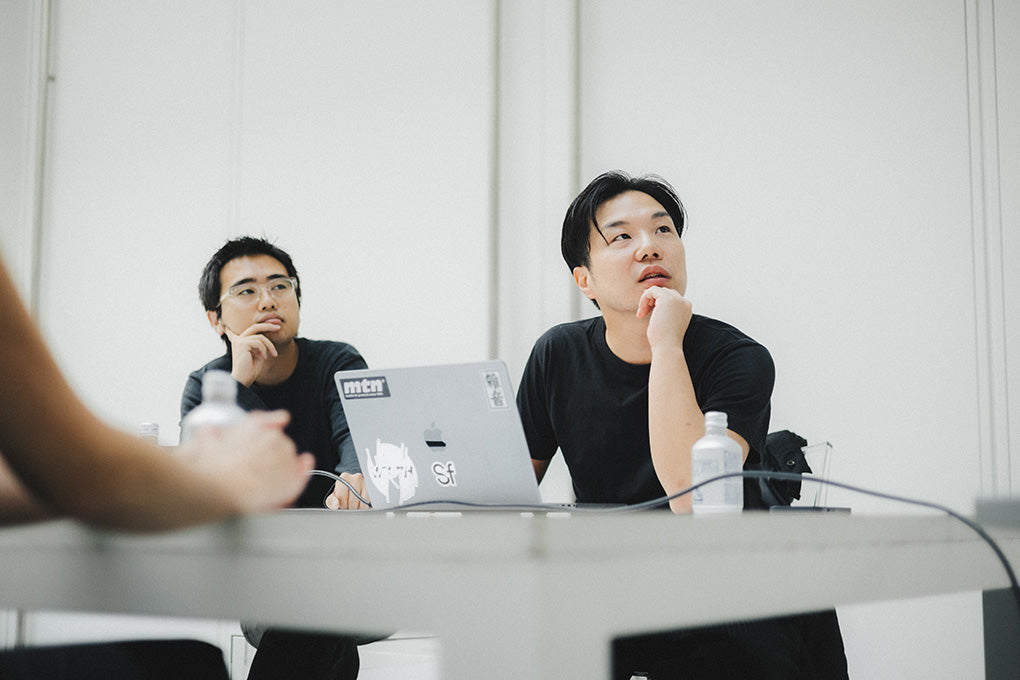
Synflux
Founded in 2019 by Kazuya Kawasaki and Kotaro Sano, Synflux is a speculative design laboratory with the mission of “fashion for the planet”. The company is focused on the development and commercialization of next-generation design systems for sustainable fashion, specifically through the creation of Algorithmic Couture. This system utilizes algorithms to design clothing that minimizes fabric waste, is mindful of the natural environment, and is tailored to fit individual wearers. Synflux works with various companies and brands to implement this approach. Additionally, the company engages in research and development related to fashion’s circularity, optimization in production, and offers support for sustainable fashion initiatives.










